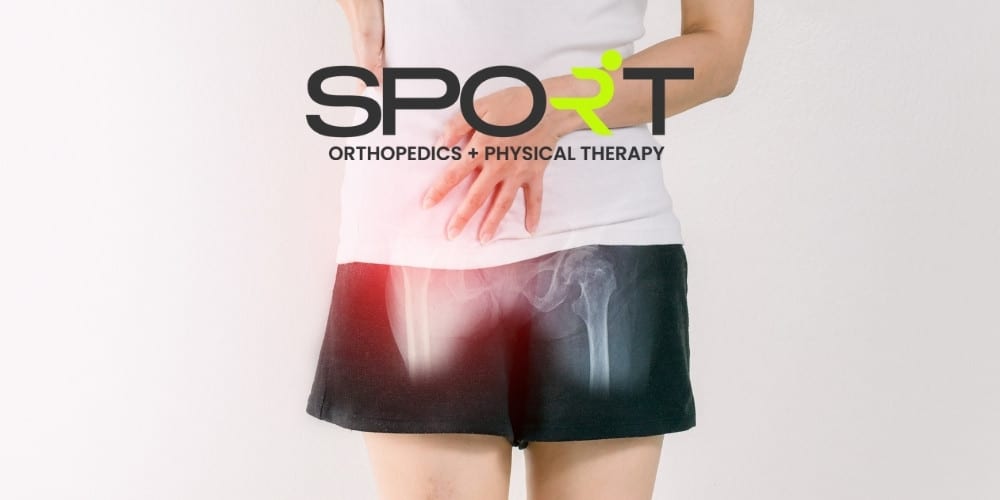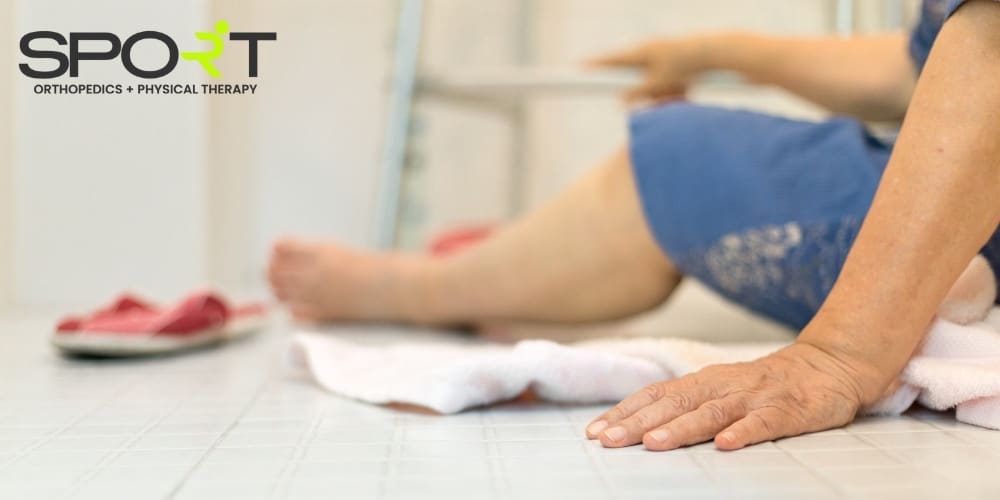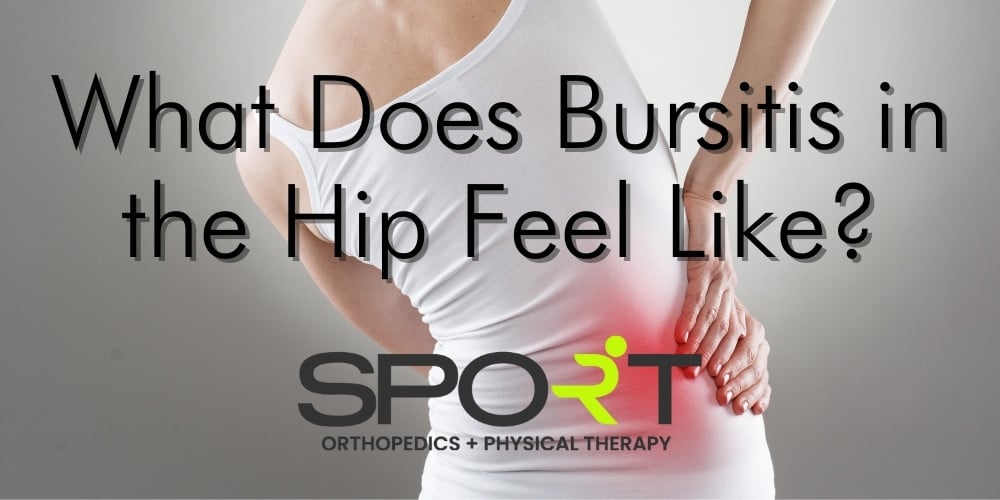Hip pain is very difficult to live with, especially if you have a highly active lifestyle. If you’re experiencing this pain for the first time, you might not yet know what’s causing it. Most people might assume that their pain comes from either arthritis or trauma. However, hip bursitis is another common cause of hip pain. But what does bursitis in the hip feel like? Is it similar to arthritis or markedly different? In this blog, the sports medicine doctors at SPORT Orthopedics + Physical Therapy are here to explain what hip bursitis is and how it differs from arthritis.
We also explain the diagnostic and treatment options available to you at our Dallas and Frisco locations. If you sustained a sports injury, or if you’re suffering from regular wear and tear pain, we can help you get back on your feet and back in the game in no time. For more information about the treatments we offer, please call our office at 469-200-2832 today.
What Is Hip Bursitis?
Bursitis is the inflammation and irritation of the bursa, which are small, fluid-filled sacs located between the bones and the soft tissues in your body. They basically act as a cushion for your joints and help reduce friction. The bursae are located in all of your body’s joints. Hip bursitis occurs when the bursae in your hips become inflamed. It is also called greater trochanter pain syndrome or greater trochanteric pain syndrome.
Additionally, there are two main types of hip bursitis: trochanteric bursitis and iliopsoas bursitis. Trochanteric bursitis is identified by an inflammation of the trochanteric bursa. These bursae are located near the portion of your hip called the greater trochanter. Iliopsoas bursitis is identified by an inflammation of the iliopsoas bursa. These bursae are located under the iliopsoas muscle at the front of the hip. While trochanteric bursitis is more common, they both require similar treatments.
Arthritis vs Hip Bursitis
It may be difficult at first to determine whether your pain comes from the inflammation of your hip bursa or from arthritis in your hip joint. Many professionals associate arthritis pain with patients experiencing worse pain in the mornings. It also tends to develop very slowly over time.
However, hip bursitis pain feels very intense at first, then lessens to a dull ache. It is important to accurately describe your pain when you see a doctor. This will greatly help in their diagnosis and treatment of your pain.
How Do I Know If I Have Hip Bursitis?

As with many similar conditions, bursitis of the hip can be identified mostly by its symptoms. However, there are a few telltale signs that may indicate that you have hip bursitis rather than another condition, such as bone spurs.
When you first experience symptoms of trochanteric bursitis, you will feel sharp pain. This sharp pain usually lasts for a few days. After that, it will feel more like a dull, more widespread ache. You will likely notice that your pain worsens as you rise from a chair, get out of bed, or while climbing stairs. Additionally, the pain tends to worsen if you sit down for too long or if you sleep on the affected hip side.
If you wait too long before seeking treatment, the affected fluid-filled sac (bursa) will thicken. This makes the swelling and pain worse. It can also result in atrophy of the hip muscles (resulting in muscle weakness) and limit your range of motion in the affected area.
What Does Bursitis of the Hip Feel Like?
When you first start developing hip bursitis, you’ll find that your pain is sharp and intense. It may begin in one specific area, but it will spread throughout the thigh, groin, and the rest of your hip. You will also feel an increase in pain and stiffness after too much or too little exercise. While walking, climbing stairs, or squatting down, you will likely feel pain. Unlike arthritis, your pain will likely feel worse at night.
Where Do You Feel Bursitis Hip Pain?
This depends on what type of hip bursitis you experience. Trochanteric bursitis affects the outside area of the hip, where your thigh curves outward. Iliopsoas bursitis affects more of the groin area than the thigh area.
What Causes Hip Bursitis?

Some people experience iliopsoas or trochanteric bursitis as a result of trauma or a hip injury. This is one of the more obvious causes of hip pain. However, it can also arise from certain diseases and other risk factors. Some people may even experience bursitis because of the anatomy of their pelvis. The following are some of the most common causes of hip bursitis.
- Trauma or injury: If you fall onto your hip or strike your hip against a hard surface, this could cause inflammation of the bursa. Bursitis resulting from trauma is called traumatic hip bursitis.
- Repetitive motion injuries: Those who frequently engage in repetitive motions of the hips are more likely to develop bursitis. Repetitive motions cause mini-traumas to the bursa in the hips, leading to inflammation.
- Underlying medical conditions: Those who are already more prone to joint pain from underlying conditions are more likely to suffer from bursitis. Examples of these conditions include gout and rheumatoid arthritis.
- Being overweight: Excess weight puts strain on the joints in the body, including the hips. This strain can increase one’s risk of hip bursitis.
- Physical conditions: Certain other conditions can increase the risk of hip bursitis. Examples include spine disease, leg length differences, scoliosis, and other spine problems.
- Bone spurs and calcium deposits: A bone spur is a small, bony point of the hip that irritates the bursa and soft tissue in the joint.
- Gender and age: Women are more likely to experience bursitis of the hip than men. Also, middle-aged adults are more likely to report hip pain.
- Previous surgery: Any previous surgeries in or around the hip increases one’s risk of bursitis pain.
- Septic hip bursitis: Bacterial infections in the bursa can cause septic bursitis pain.
Symptoms of Hip Bursitis
- Joint pain
- Tenderness
- Swelling of the affected side
- Warmth around the affected area
- Sharp pain
- Dull, aching pain
- Muscle weakness
- Limited range of motion
How to Diagnose Hip Bursitis
Before we conduct any tests, we will ask about your medical history and conduct a physical examination of the hips. We will focus on identifying the source of your pain, checking your mobility, and testing your strength.
Then, we will likely order certain imaging tests, such as X-rays and MRIs (magnetic resonance imaging). This will help us in ruling out other possible sources of your pain. Additionally, we may take a fluid sample from the inflamed bursa to test for other conditions.
How to Treat Hip Bursitis

For mild cases of bursitis, you can begin with conservative home treatments. When you first experience symptoms, we recommend taking the following steps.
- Get plenty of rest, but don’t stay completely immobile for long periods of time.
- Use ice and cold therapy to reduce your pain and swelling for the first few days.
- Alternate between using heat and cold therapy after the first few days
- Take over-the-counter NSAIDs (nonsteroidal anti-inflammatory drugs) to relieve pain and reduce inflammation
- If you are a side-sleeper, use a thin pillow between your knees to cushion them and align your hips at night.
Nonsurgical Treatments for Hip Bursitis
If your at-home treatments prove fruitless, we will likely begin with physical therapy sessions. Another conservative option is the injection of corticosteroid medicine (steroid injections). These injections help to control inflammation. In most cases, this will resolve your pain. Other conservative treatment options include the following.
- Wearing a properly fitting shoe insert
- Using a walking cane or crutches
- Lose weight. Losing weight can take the strain off of your hip joints.
- Extracorporeal shock wave therapy
- Percutaneous tenotomy
Surgery for Hip Bursitis

If conservative treatments do nothing to alleviate your pain, we may recommend minimally invasive surgery to remove the bursa. We only recommend surgical removal after all other options have failed to alleviate your pain. The minimally invasive procedure will involve arthroscopic removal of the bursa. This helps to both minimize scarring and shorten recovery times. Other surgical options include the following.
- Tendon repair
- Iliotibial band release
- Greater trochanter osteotomy
Hip Bursitis Treatment in Dallas and Frisco at SPORT
If you experience frustrating hip pain, the orthopaedic surgeons and physical therapists at SPORT are here to help. Our experienced professionals are highly skilled at treating bursitis. We can quickly diagnose and treat your pain so that you can get back to enjoying the activities you love. To schedule an appointment with a physical therapist, please call our office at 469-200-2832 today.



